Understanding Search Intent: The Key to Effective SEO


Search intent shapes everything we do online. Every Google search hides a motive and yet, even top marketers often ignore its real influence. Studies show that understanding intent can drive up conversion rates and organic rankings in double digits. Most people obsess over keywords, but it is the hidden 'why' behind those words that unlocks next-level digital success.
Table of Contents
- Defining Search Intent: What It Is And Why It Matters
- The Importance Of Search Intent In Digital Marketing
- Types Of Search Intent: Navigational, Informational, And Transactional
- How Search Intent Influences SEO Strategies
- Real-World Applications Of Understanding Search Intent
Quick Summary
| Takeaway | Explanation |
|---|---|
| Understand search intent | Identifying the specific reason behind a search query is vital for creating relevant content. |
| Match content to user needs | Aligning content with different search intent types enhances engagement and satisfaction. |
| Improve SEO through intent | Focusing on search intent helps optimize content for better search engine rankings. |
| Target specific customer motivations | By analyzing user queries, businesses can create content that addresses exact customer needs. |
| Use search intent for conversion | Recognizing transactional intent allows businesses to craft effective marketing strategies that drive purchases. |
Defining Search Intent: What It Is and Why It Matters
Search intent represents the underlying motivation driving a user's online search query. At its core, understanding search intent means comprehending the precise objective a person has when typing words into a search engine. Learn more about keyword targeting strategies to enhance your understanding of user search behaviors.
The Core Components of Search Intent
Search intent can be categorized into several fundamental types that reveal user objectives:
- Informational Intent: Users seeking knowledge or answers to specific questions
- Navigational Intent: Users looking to find a particular website or webpage
- Transactional Intent: Users prepared to make a purchase or complete an action
- Commercial Investigation Intent: Users researching products before making a buying decision
According to research from the Pacific Asia Conference on Information Systems, understanding these intent categories is crucial for delivering precise, relevant search results. Each intent type signals a different user expectation and requires a tailored content approach.
Why Search Intent Matters for Digital Success
Recognizing search intent transforms how businesses and content creators approach online visibility. Search engines like Google increasingly prioritize user experience, which means matching content precisely with what users actually want. By aligning content with specific search intents, websites can dramatically improve their:
- Organic search rankings
- User engagement metrics
- Conversion rates
- Overall content relevance
Understanding search intent is not just a technical exercise but a strategic approach to connecting with your audience exactly where and how they seek information. It bridges the gap between user expectations and content delivery, creating a more intuitive and satisfying online experience.
The Importance of Search Intent in Digital Marketing
Search intent has become a transformative concept in digital marketing, shifting how businesses approach online communication and customer engagement. Learn more about digital marketing strategies to understand how search intent drives successful online campaigns.
Connecting Content with Customer Needs
In digital marketing, search intent serves as a critical bridge between user expectations and brand messaging. By decoding the underlying motivations behind search queries, marketers can craft more targeted, relevant content that resonates directly with their audience's specific needs and desires.
According to research exploring information search behavior models, understanding search intent goes beyond simple keyword matching. It involves a nuanced approach to comprehending user knowledge acquisition and information-seeking patterns. This means digital marketers must think beyond traditional advertising techniques and focus on providing genuine value through precisely targeted content.
Strategic Benefits of Search Intent Alignment
Aligning marketing content with search intent offers multiple strategic advantages for businesses:
- Enhanced User Experience: Content that directly answers user questions increases engagement and satisfaction
- Improved Conversion Rates: Targeted content speaks directly to user needs, increasing likelihood of action
- Better Search Engine Rankings: Search engines reward content that effectively matches user intent
- More Efficient Marketing Spend: Resources are directed toward creating content with proven relevance
By treating search intent as a strategic asset, digital marketers can transform their approach from broad, generic messaging to precise, user-centric communication.
The following table summarizes the strategic benefits of aligning your content and marketing efforts with user search intent, as discussed in the previous section.
| Benefit | Description |
|---|---|
| Enhanced User Experience | Content directly addresses user questions, increasing satisfaction |
| Improved Conversion Rates | Targeted messaging increases the chance users take desired actions |
| Better Search Engine Rankings | Search engines reward content that matches user intent |
| More Efficient Marketing Spend | Efforts are focused on high-impact, relevant content |
| Long-Term Trust and Credibility | Consistently meeting needs builds authority and loyalty |
Types of Search Intent: Navigational, Informational, and Transactional
Search intent represents a sophisticated framework for understanding user behavior online, categorized into distinct types that reveal the underlying motivations behind digital queries. Explore our guide on search visibility metrics to gain deeper insights into how these intent types impact digital performance.
Understanding the Primary Search Intent Categories
Each search intent type reflects a unique user objective, providing critical context for content creators and marketers.
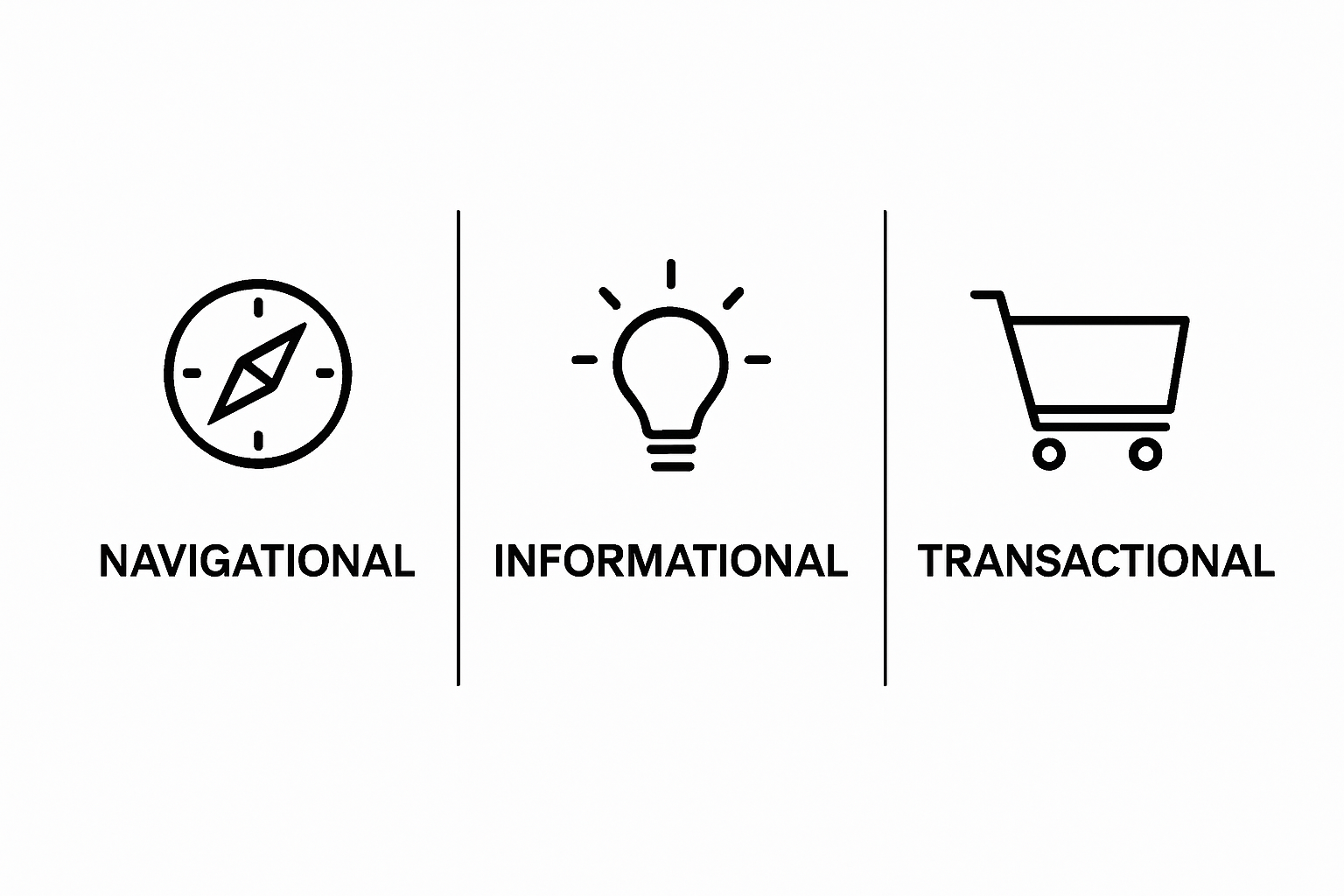 According to research from the ACM Digital Library, these categories represent fundamental patterns in web search behavior:
According to research from the ACM Digital Library, these categories represent fundamental patterns in web search behavior:
Detailed Breakdown of Search Intent Types
1. Navigational Intent
Users with navigational intent seek a specific website or webpage. They typically know exactly where they want to go and use search engines as a direct pathway. Examples include:
- Searching for "Facebook login"
- Typing "YouTube homepage"
- Looking for "Gmail account"
2. Informational Intent
Informational searches aim to acquire knowledge or answer specific questions. These users are seeking detailed explanations, guides, or insights about a particular topic. Typical scenarios include:
- Researching "how to bake chocolate chip cookies"
- Understanding "symptoms of vitamin D deficiency"
- Learning "history of artificial intelligence"
3. Transactional Intent
Transactional searches indicate a user's readiness to complete an action, typically involving a purchase or signup. These queries demonstrate high commercial potential and immediate conversion opportunities. Examples include:
- "Buy running shoes online"
- "iPhone 14 best price"
- "Yoga class registration near me"
By recognizing these distinct search intent categories, businesses can strategically develop content that precisely matches user expectations, ultimately improving engagement, conversion rates, and overall digital marketing effectiveness.
To help you quickly compare the main categories of search intent, the table below outlines their core purpose, user motivation, and typical search examples.
| Search Intent Type | Core Purpose | User Motivation | Example Search Query |
|---|---|---|---|
| Navigational Intent | Find a specific website or webpage | Reach a known site directly | Facebook login |
| Informational Intent | Acquire knowledge or answers | Learn or understand a topic | How to bake chocolate chip cookies |
| Transactional Intent | Complete a purchase or action | Buy or sign up for something | Buy running shoes online |
| Commercial Investigation | Research products before buying | Compare or evaluate options | Best laptops 2024 |

How Search Intent Influences SEO Strategies
Search intent has fundamentally transformed SEO strategies, compelling digital marketers to move beyond traditional keyword optimization toward more nuanced, user-centric approaches. Discover advanced SEO growth strategies for 2025 to understand how search intent drives modern optimization techniques.
The Paradigm Shift in SEO Optimization
Traditionally, SEO focused primarily on keyword density and backlink volume. However, contemporary strategies recognize that understanding user intent is far more critical than mechanical optimization. Search engines like Google have developed sophisticated algorithms that prioritize content relevance and user satisfaction over simplistic ranking metrics.
According to research exploring search intent bias in ranking algorithms, understanding user intent can substantially improve content retrieval performance. This means SEO professionals must now think like their target audience, anticipating not just what keywords they might use, but why they are searching.
Strategic Implications of Search Intent for SEO
Search intent influences SEO strategies across multiple dimensions:
- Content Creation: Develop content that directly addresses specific user needs and questions
- Keyword Selection: Choose keywords that reflect genuine user motivations, not just search volume
- User Experience Design: Structure content to provide immediate, clear answers
- Conversion Optimization: Align content with specific stages of user journey and intent
By integrating search intent into SEO strategies, businesses can create more targeted, meaningful content that not only ranks higher but genuinely serves user needs.
This approach transforms SEO from a technical exercise to a user-centric communication strategy, ultimately driving more authentic engagement and improved digital performance.
Real-World Applications of Understanding Search Intent
Search intent analysis has evolved from a theoretical concept to a practical tool transforming digital strategies across multiple industries. Learn more about SEO strategies for niche markets to see how precise intent understanding drives targeted marketing efforts.
E-Commerce and Conversion Optimization
In the e-commerce landscape, understanding search intent enables businesses to create highly targeted product pages and marketing campaigns. Retailers can now anticipate customer needs by analyzing the specific motivations behind search queries, whether users are researching products, comparing options, or ready to make a purchase.
According to research exploring web search query interactions, detecting user intent allows websites to dynamically adjust content and recommendations, significantly improving user experience and conversion rates.
Strategic Applications Across Industries
Search intent analysis provides practical benefits in various sectors:
- Healthcare: Tailoring medical information to match patient research patterns
- Education: Creating targeted learning resources based on student search behaviors
- Travel: Developing personalized booking experiences
- Financial Services: Designing content that addresses specific financial planning queries
These applications demonstrate how understanding search intent transforms generic digital interactions into personalized, meaningful experiences. By recognizing the nuanced motivations behind user searches, businesses can create more responsive, user-centric digital strategies that directly address customer needs and expectations.
Transform Search Intent Insights Into Real SEO Growth
Struggling to turn deep understanding of search intent into concrete results for your business? As covered in this article, knowing what your customers want—whether it is informational, navigational, or transactional content—is the key to higher rankings and better conversions. Yet, many businesses find it tough to match this knowledge with content that truly drives organic traffic or builds lasting online visibility. If you are looking for a smarter way to connect intent, automation, and results, you deserve a content solution that works as intuitively as your audience thinks.
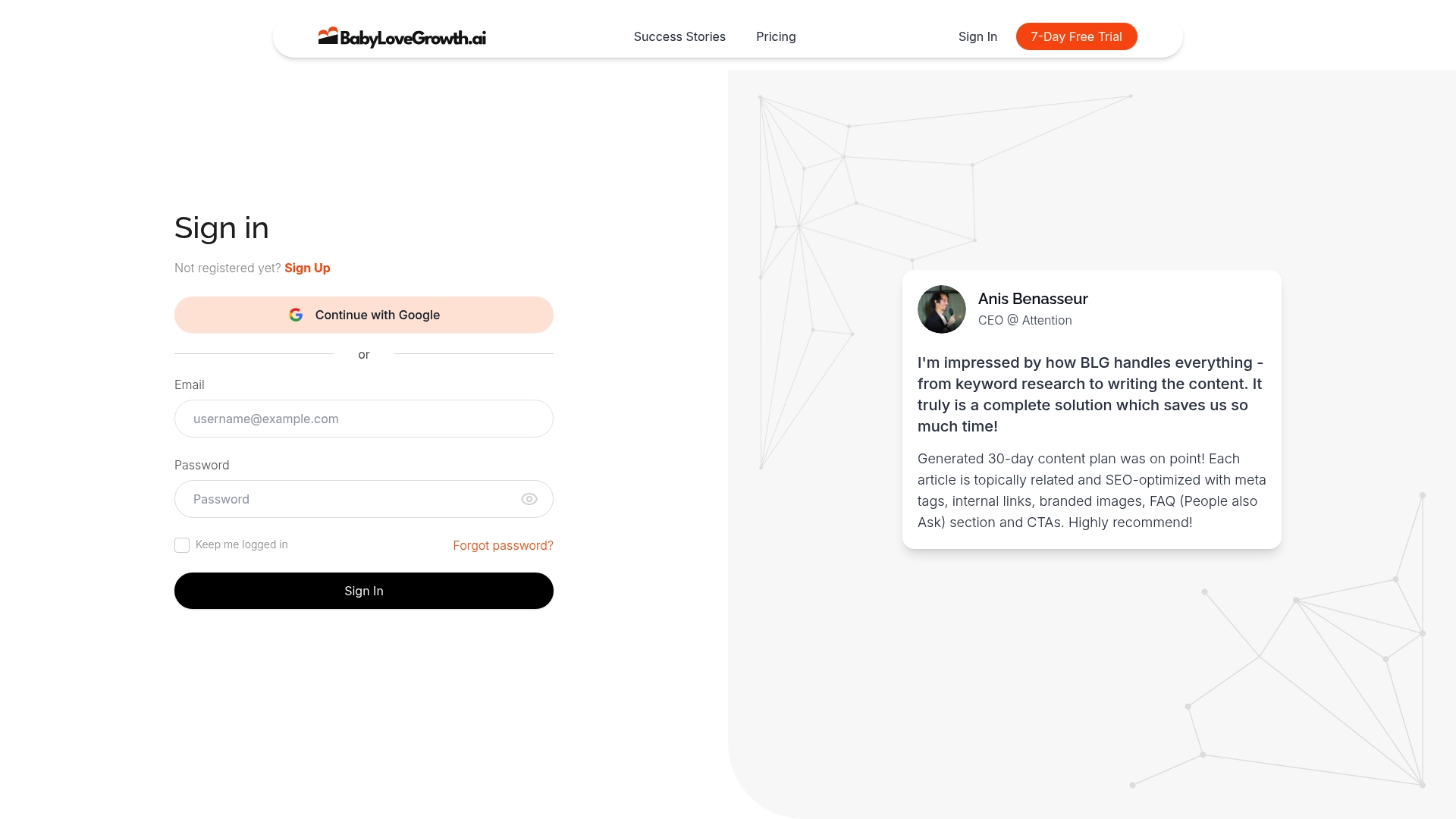
At babylovegrowth.ai, we help you bridge the gap between understanding what your audience needs and delivering it at scale. Our AI-powered platform creates automated, search intent-driven articles and a 30-day content plan that aligns exactly with user demand. Get high-impact backlinks and see your rankings improve without the hassle. Ready to see the difference true search intent optimization can make? Start your free trial today and let your organic traffic and conversions grow the smart way.
Frequently Asked Questions
What is search intent and why is it important for SEO?
Search intent is the underlying motivation behind a user's search query. Understanding search intent is crucial for SEO because it helps align content with user expectations, thereby improving organic search rankings, engagement, and conversion rates.
What are the main types of search intent?
The main types of search intent include informational intent (seeking knowledge), navigational intent (looking for a specific site), transactional intent (ready to make a purchase), and commercial investigation intent (researching products before buying).
How can businesses align their content with search intent?
Businesses can align their content with search intent by analyzing user queries to understand their motivations, developing targeted content that addresses specific user needs, and optimizing for keywords that reflect genuine user searches.
How does understanding search intent affect digital marketing strategies?
Understanding search intent influences digital marketing strategies by allowing marketers to create more relevant, user-centric content. This leads to enhanced user experiences, improved conversion rates, and better overall marketing effectiveness.
Recommended
Smart SEO,
Faster Growth!
Most Read Articles
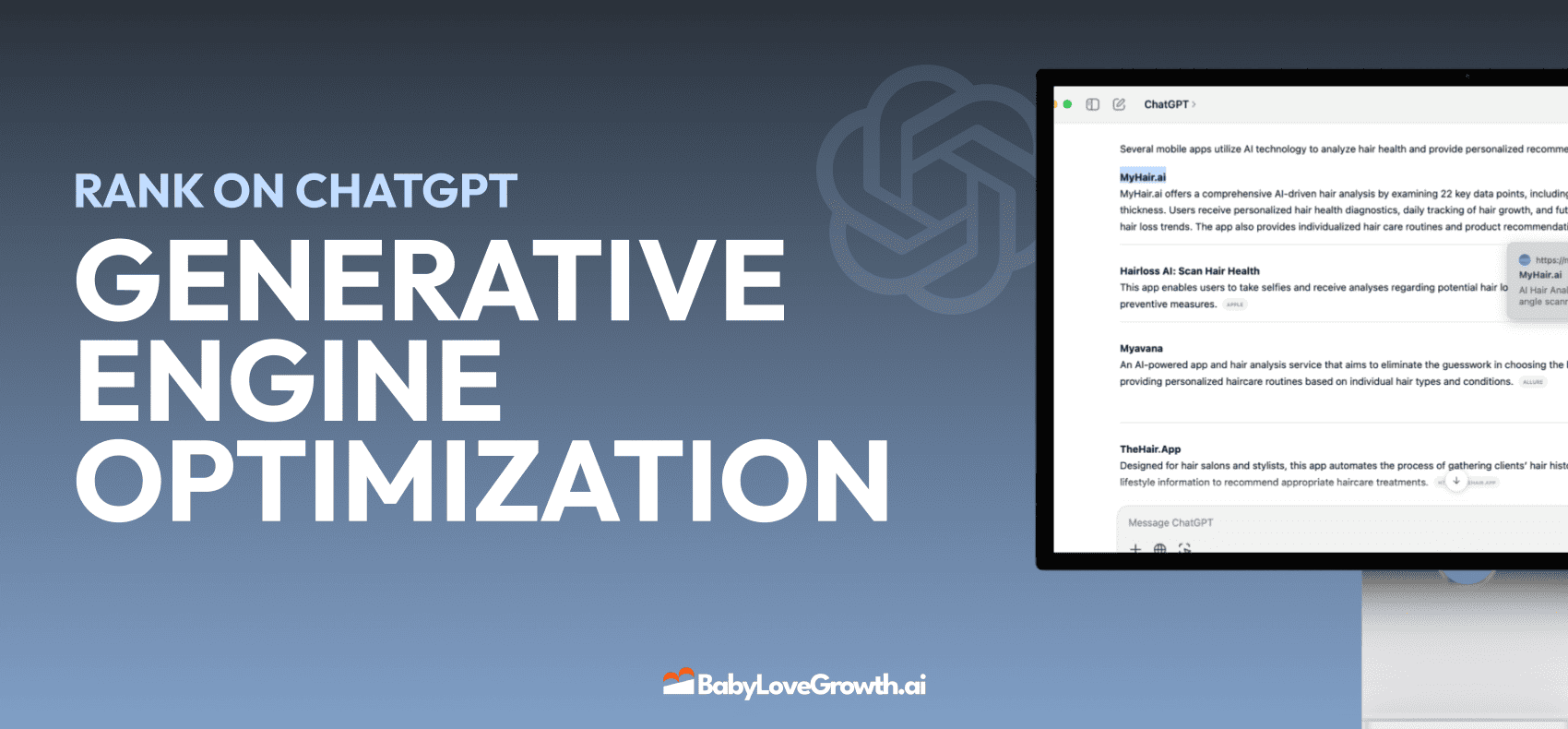
Generative Engine Optimization (GEO)
Learn how Generative Engine Optimization (GEO) helps your content rank in AI search engines like ChatGPT and Google AI. This comprehensive guide explains the differences between SEO and GEO, why it matters for your business, and practical steps to implement GEO strategies for better visibility in AI-generated responses.
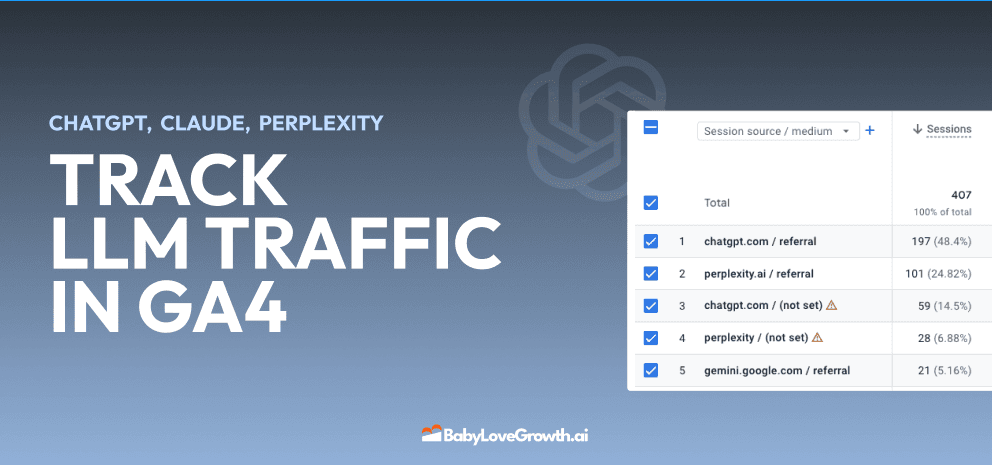
Track LLM Traffic in Google Analytics 4 (GA4)
Learn how to track and analyze traffic from AI sources like ChatGPT, Claude, Perplexity, and Google Gemini in Google Analytics 4. This step-by-step guide shows you how to set up custom filters to monitor AI-driven traffic and make data-driven decisions for your content strategy.
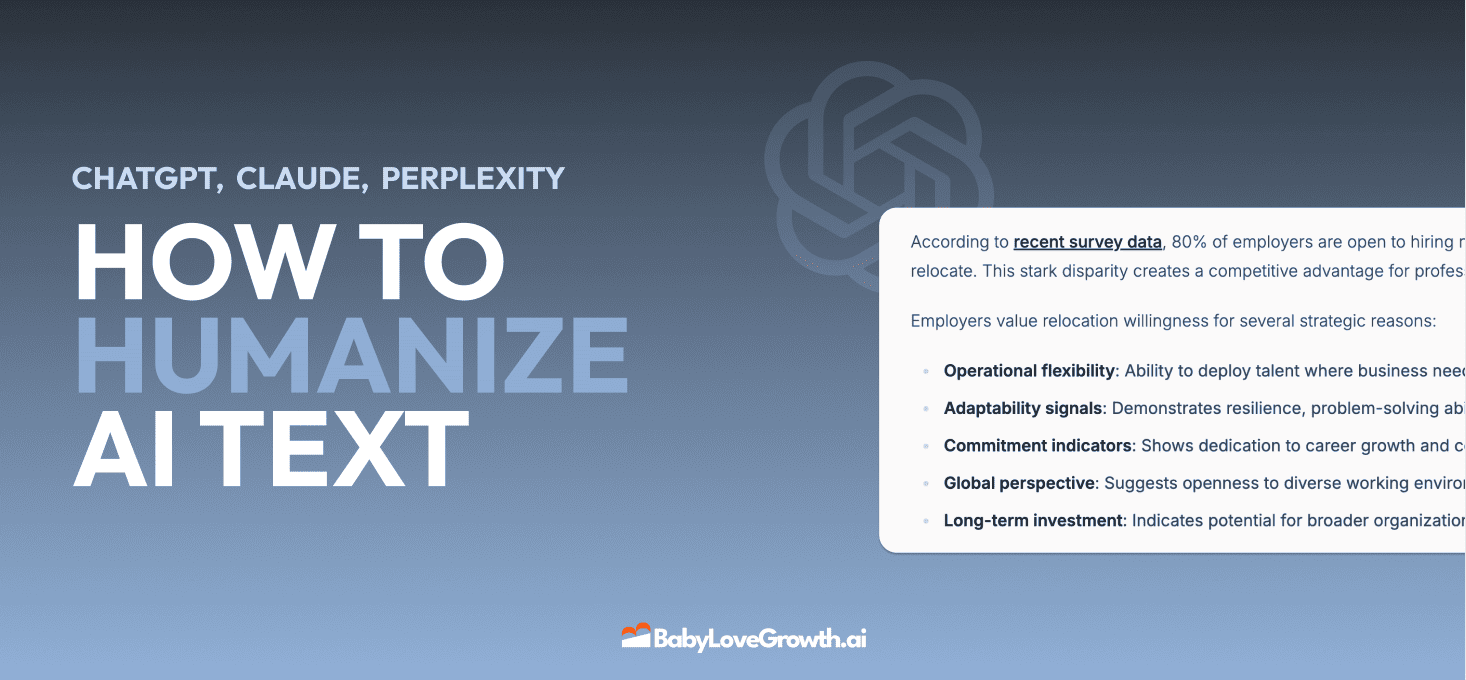
How to Humanize AI Text with Instructions
Learn practical techniques to make AI-generated content sound more natural and human. This guide covers active voice, direct addressing, concise writing, and other proven strategies to transform robotic text into engaging content.
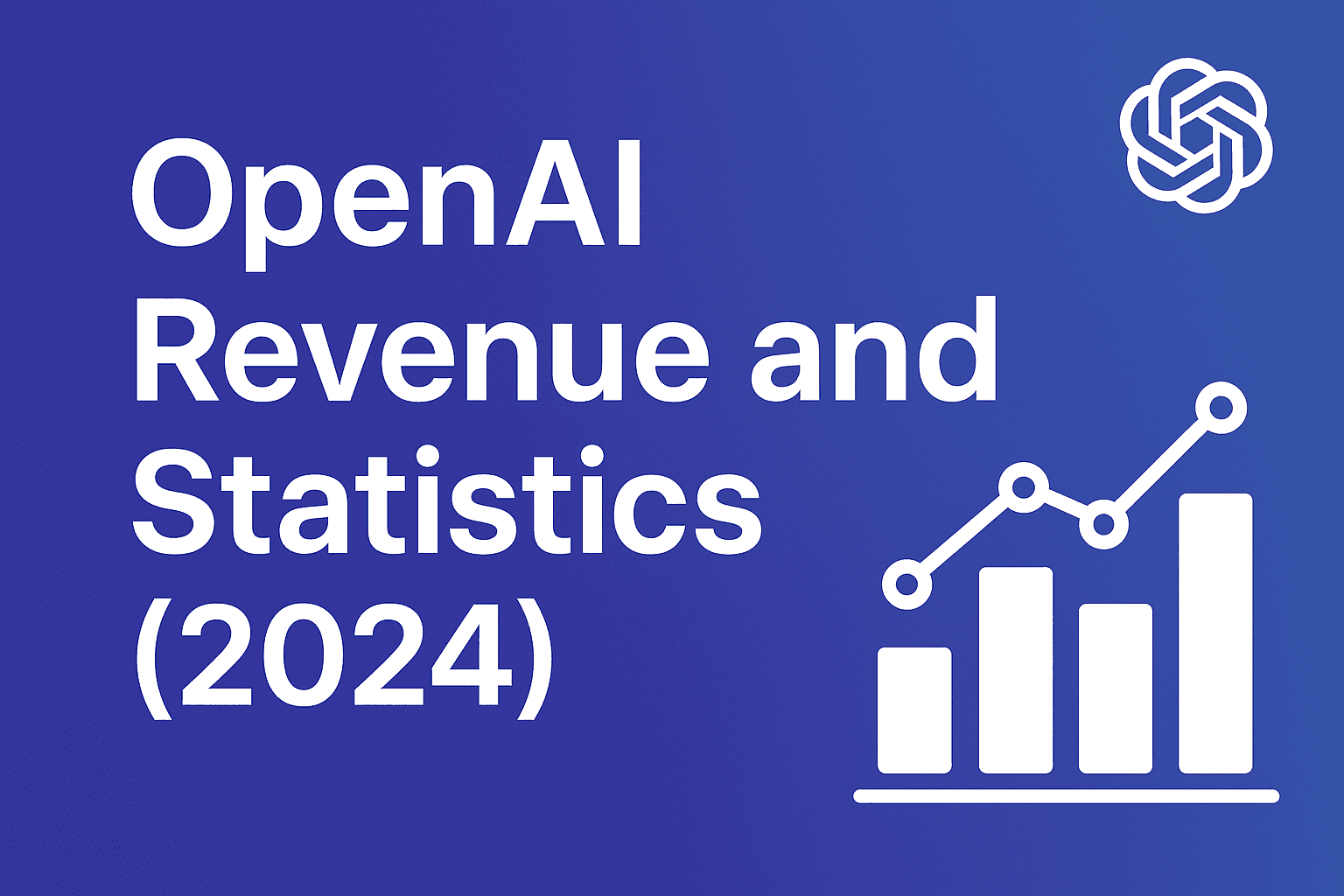
Open AI Revenue and Statistics (2024)
Comprehensive analysis of OpenAI financial performance, user engagement, and market position in 2023. Discover key statistics including $20B valuation, $1B projected revenue, and 100M+ monthly active users.